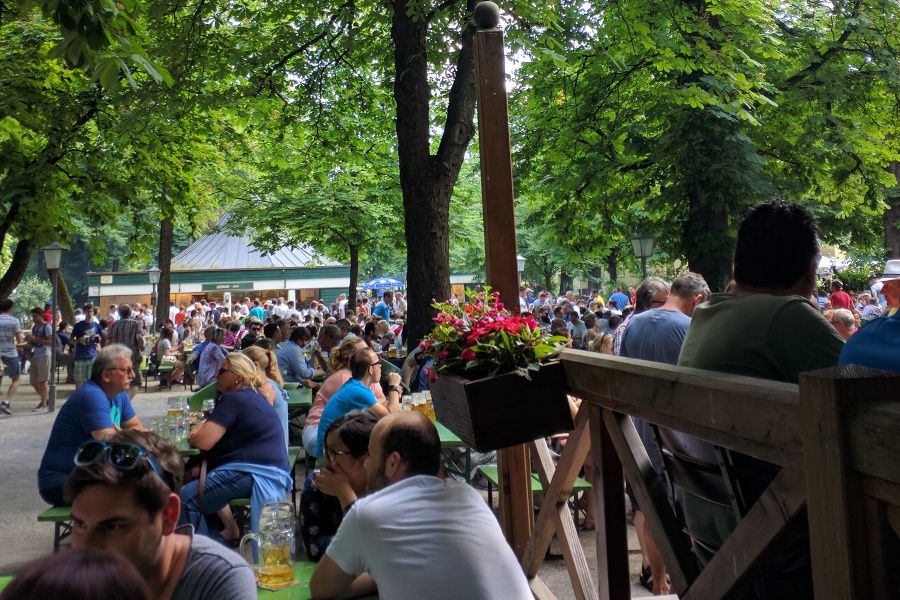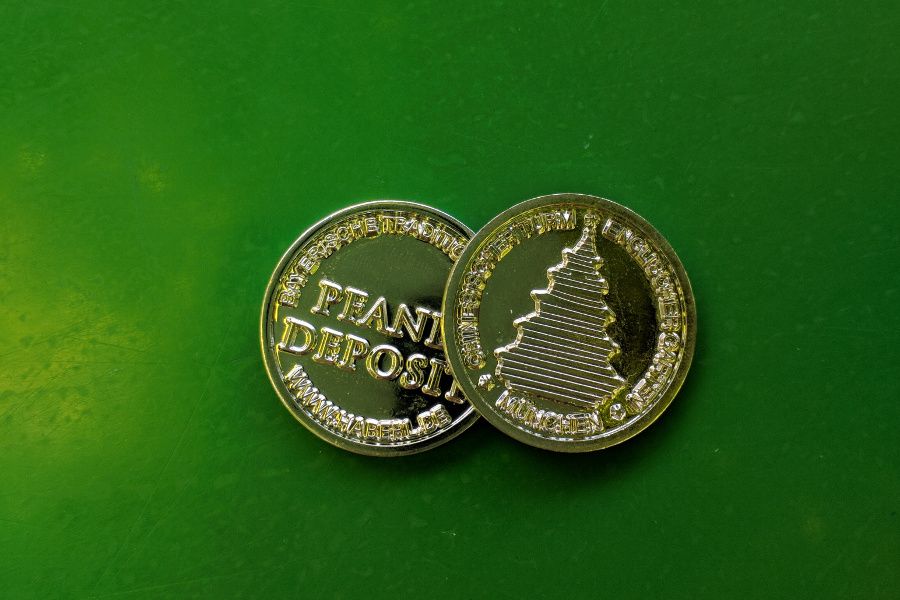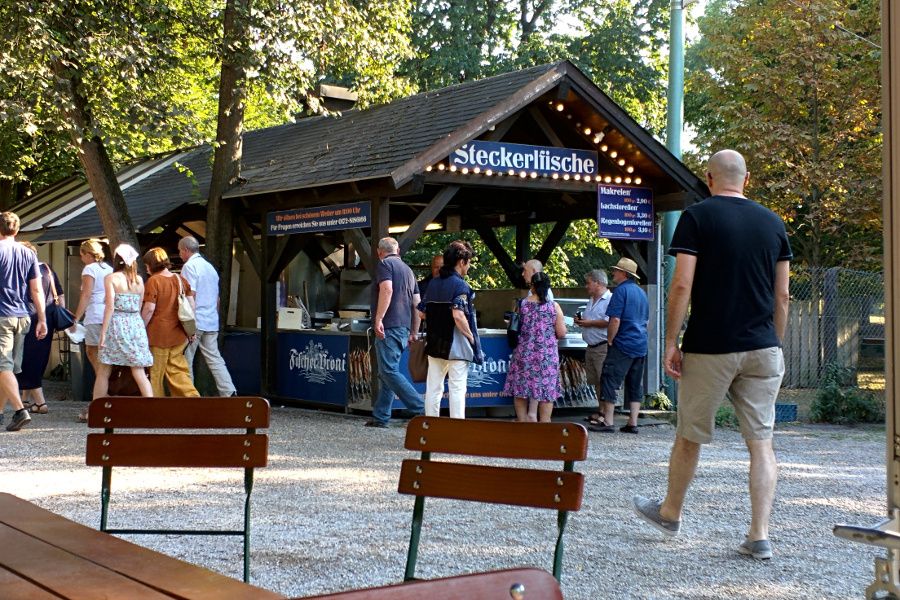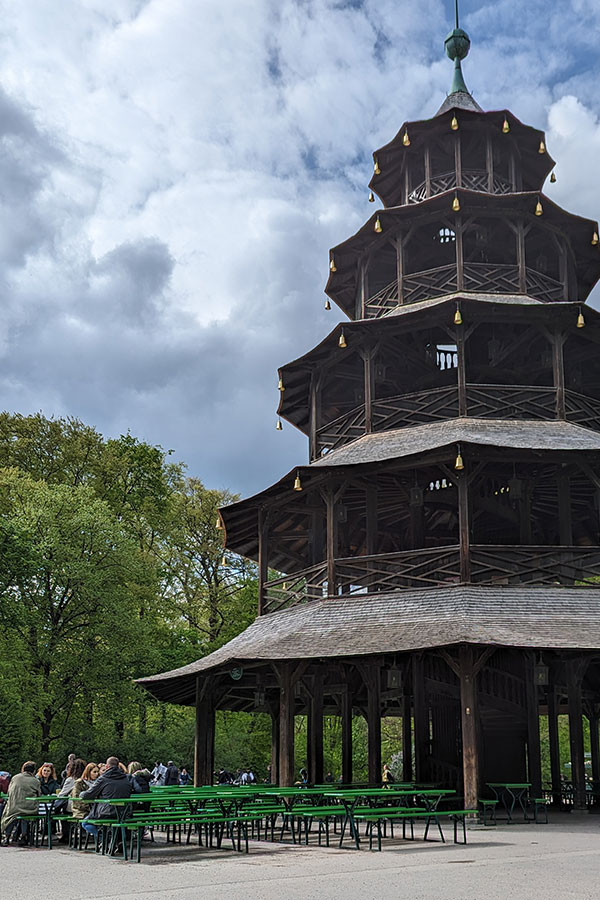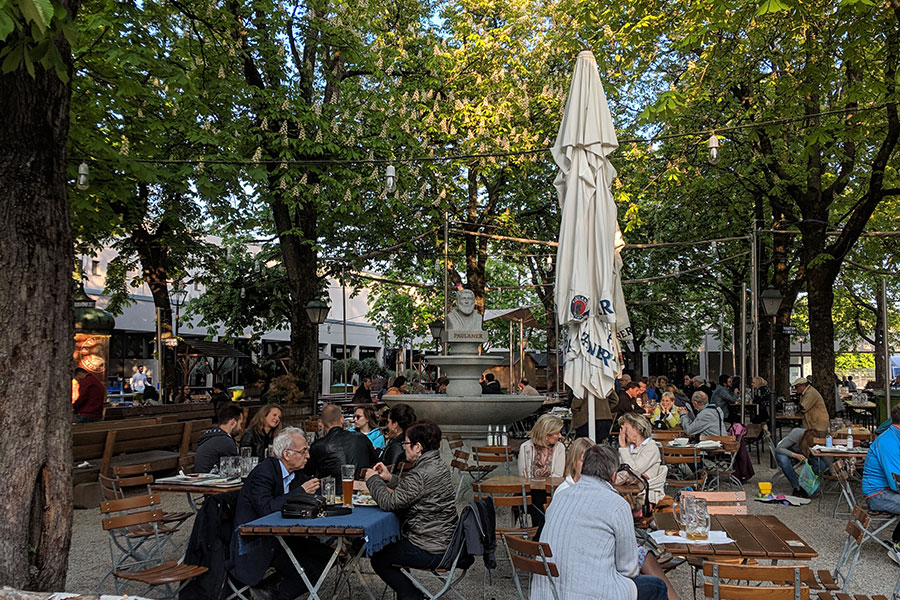As soon as there is the slightest hint of warm or nice weather, Biergärten (that’s plural for Biergarten) across Bavaria will start popping up. Those long wooden tables and large umbrellas will show up in green spaces and on sidewalks. It’s a sure sign that spring has arrived after months inside at a favorite Wirtshaus, or pub.
The Munich Biergärten serve traditional Bavarian food in addition to having a friendly, joyful, and fun atmosphere. And, of course, they serve that internationally famous Munich beer.
Biergärten are a classic and integral part of the Bavarian lifestyle that can be confusing for outsiders: are they or aren’t they a restaurant?
In this guide, I want to share some of my favorite Munich Biergärten and provide an overview of what to expect, etiquette, and food.
Table of Contents
🍻 Munich Biergarten Essentials
Munich’s Biergärten are an integral part of the city’s social life and a cornerstone of the Bavarian lifestyle. These open-air beer gardens are the perfect place to enjoy traditional food, world-famous Munich beer, and a friendly, joyful atmosphere as soon as the weather gets warm. Whether you’re at a full-service table or a self-service area where you can bring your own food, understanding a little etiquette will help you feel right at home.
🔍 Not sure where to start?
- For the best overall and a local favorite experience, head to Hirschgarten. It’s the largest in the world and offers a perfect window into local life.
- For the best classic tourist experience, visit the Biergarten am Chinesischen Turm in the Englischer Garten, a famous landmark beloved by guidebooks and locals.
- For the best family-friendly spot, check out Augustiner-Keller, which has a laid-back atmosphere and a playground for the kids.
- For the most unique experience, try the Biergarten auf dem Viktualienmarkt, where the brewery on tap rotates and you can pair your beer with treats from the market stalls.
- For the best hidden gem, reward yourself with a visit to the slightly more upscale Nockherberg for delicious food and a fun atmosphere.
So what is a Biergarten?
A Biergarten is an open-air collection of tables where you can buy drinks, including beer.
There are two types of Biergärten.
The first is a full-service Biergarten. That is, an outdoor seating area of a restaurant. Staff will take your order at the table and bring you your order.
The second is a self-service Biergarten. Traditionally, at a self-service Biergarten, you can bring your own food, but you must buy your drinks from the Biergarten — usually from a drinks stand. A self-service Biergarten may also sell food, typically cafeteria-style from kiosks or permanent outdoor buildings, that will range from full meals to snacks and sweets.
While Bavaria is famous for its Biergärten, the concept largely operates the same across Germany (and into Austria). Once you learn the ropes of the Biergarten, it will generally apply across the German-speaking world.
Biergarten Etiquette & Tips
Here are a few quick and easy tips to help make your next visit to a Biergarten in Munich more pleasant.
Tablecloth vs No Tablecloth
Some Biergarten will offer both full-service and self-service. But there are a few telltale signs to know which section is which.
First, a table with a tablecloth typically indicates it’s a full-service table. Keep in mind that some visitors to the Biergarten do bring their own tablecloth for the self-service section, but they typically will look different.
Also, keep your eyes peeled for a sign (look for “Selbstservice”) indicating self-service.
Ordering
For self-service, food and drink are available at stands (“Schränke”) where you can order or pick up what you’re interested in. In a larger Biergarten, it will typically operate cafeteria-style, where you pick up your food on a tray and then take it to a separate stand to pay.
For table service, grab a menu off the table and hold tight! A waiter or waitress will be over to take your order shortly!
Ist hier frei?
The Biergarten is a communal affair. If the place is packed, look for an empty seat instead of an empty table. If someone is already sitting at the table, ask “Ist hier frei?” (“Is this seat empty?”) Even if you don’t speak any German, you’ll likely get a universally understood nod or shake of the head.
Don’t forget to learn a little German for your next trip to make things that much easier, too!
Pfand Deposit
To discourage visitors from walking off with the beer mugs (a Krug), some Biergarten will add a deposit to the price of a drink. It’s usually only a Euro or two. At purchase time, you’ll receive a small coin or token. Before you leave the Biergarten, take your mug and the token to the Pfand Zürückgabe, or deposit return. In exchange for returning the mug safely, you’ll receive your deposit back.
Opening Hours Depend on the Weather
In the spring, typically around Easter or any unseasonably warm weather, Biergärten will begin to open up shop for the season. During the peak summer months, the Biergärten are consistently open each day unless there’s particularly bad weather.
During the less busy months – early in spring or after Oktoberfest – the schedule of Biergärten can be a little less certain. Each one is different, with some particularly sensitive to threats of rain or cold weather. Some will close early if they aren’t doing enough business. These days, many do update their websites to announce when they’re open, but it’s still not a certainty.
For the most current information, always check the Biergarten’s official website or Google Maps listing on the day of your visit.
What to Order at the Biergarten
There is some standard fare you can expect to find in most (but not all) Biergarten.
- Steckerlfisch are fish roasted on sticks. Salty and flavorful, you buy a fish by weight, usually an entire fish at a time. It’s a very Bavarian specialty that’s worth experiencing.
- Hendl is roast chicken that’s typically sold as half a chicken.
- Obatzda is a Bavarian cheese spread made of soft cheese (usually a camembert or a brie), butter, paprika, a touch of beer, and some other seasonings. It’s usually eaten on bread or pretzels with radishes.
- Wurstsalat, literally meaning “sausage salad,” is a dish of thin sausage slices and onion in a vinegar and oil-based marinade.
- Riesenbreze translated means “giant pretzel.” It’s a Biergarten classic! Bavarian pretzels are crusty on the outside with a somewhat fluffy interior, perfect for sharing. Smaller versions are typically available, too.
Biergarten Beverages
The Biergarten will undoubtedly have beer. But you can mix it up with some other common drink options.
- Radler combines beer with lemon soda.
- Russ is lemon soda and Weissbier.
- Schorle is a non-alcoholic beverage that mixes sparkling water and fruit juice. Apfelschorle, using apple juice, and Johannisbeerschorle, using black currant juice, are the most common.
- Spezi is another non-alcoholic drink that combines orange soda and cola.
Beers are typically sold in two main sizes: a Maß (a one-liter mug) and a Halbe (a half-liter glass).
The Best Biergärten in Munich
Here’s a round-up of my favorite self-service Biergärten in Munich!
Hirschgarten
For me, a visit to Hirschgarten is a ritual. It’s the first Biergarten I visit in Munich when I arrive. For me, it has a cozy feel with delicious food.
Hirschgarten is not only the largest Biergarten in Munich but in the world. Nestled in the western part of the city near Schloss Nymphenburg and surrounded by the Hirschgarten Park, it is a Munich oasis.
During the peak summer season, it can become very busy, popular with tourists and locals alike. In fact, after a long work or school day, you’ll frequently see workers and families congregating for a meal, a drink, or just to hang out in the park.
Königlicher Hirschgarten is comprised of a full-service restaurant and Biergarten as well as a self-service Biergarten. The restaurant menu is large with many options to choose from. The dishes are always guaranteed to be tasty. You can find traditional Bavarian food as well as their take on more international cuisine.
If you prefer self-service, in addition to the drink stand, the Biergarten has a large number of tasty meal options as well as pretzels, lighter fare, and sweets.
Be sure to check out the fenced area near the Steckerlfisch stand. There you will find a small herd of deer. Be sure to enjoy the park while you’re there, too. It’s a real window into life in Munich.
Königlicher Hirschgarten, Hirschgarten 1, 80639 Munich
Restaurant am Chinesischen Turm
The Biergarten am Chinesischen Turm is a well-known site and landmark in the Englischer Garten. And on nearly any nice day, you’ll find the Biergarten packed. It’s a favorite of guidebooks, tours, and tourists. But there are plenty of locals there, too.
A restaurant operates in a central location across from the tower. But it’s small compared to the Biergarten. Through the turnstiles, you’ll find the food and drink stalls offering a wide range of options. On offer are traditional dishes, salads, and even desserts. Many choose to grab a drink and a giant pretzel, then settle in at one of the long green Biergarten tables under the chestnut trees. For many, this Biergarten in Munich is a city institution.
Biergarten am Chinesischen Turm, Englischer Garten 3, 80538 München
Augustiner-Keller
The Augustiner Keller in Munich is similar to Hirschgarten but a bit more urban. Huge chestnut trees tower over the Biergarten, where you can help yourself to food and drink at the stalls, then grab a seat.
It has a more laid-back, casual atmosphere that suits families and meeting up with friends. You’ll find it’s a popular family-friendly spot with a playground for the kids. The Augustiner brewery, arguably the city’s most popular, also operates a restaurant that overlooks this Munich Biergarten.
It’s also extremely easy to get to the Munich Augustiner-Keller. It’s located a short walk from Hackerbrücke and the central bus station.
Augustiner Keller, Arnulfstraße 52, 80335 Munich
Biergarten auf dem Viktualienmarkt
Just around the corner from Marienplatz is Viktualienmarkt, the open-air market that has been operating since the early 19th century. Tucked in the center of the market area is a Biergarten.
Whereas most Biergärten and restaurants in the city are dedicated to a single brewery, this Biergarten is a little more diplomatic. Every five to six weeks, the brewery on tap changes. Six Munich breweries are on rotation: Augustiner, Hacker-Pschorr, Löwenbräu, Hofbräu, Paulaner, and Spaten.
The Biergarten auf dem Viktualienmarkt is fun because you can grab some food from one of the nearby shops. Maybe a Leberkässemmel from one of the butcher shops or a pretzel from the organic bakery Fritz Mühlenbäckerei.
Viktualienmarkt 9, 80331 Munich
Paulaner am Nockherberg
Nockherberg can feel like a bit of a hidden gem. While by no means a secret, the Paulaner restaurant and Biergarten have a slightly upscale feel.
Compared to some of the other spots listed above, the self-service Biergarten has some of the most restrictive operating hours. But if you manage to get there when they’re open, you won’t be disappointed. The food, especially the roast chicken paired with French fries, is delicious and Paulaner drinks are always flowing. And they don’t take themselves too seriously: order the Kaiserschmarrn, and you’ll be notified it’s ready with the ringing of a cowbell!
Nockherberg also hosts a fantastic Starkbierfest during the late winter.
Am Nockherberg, 81541 Munich
Frequently Asked Questions about Munich’s Biergärten
Can I bring my own food to a Biergarten in Munich?
Yes, at a traditional self-service Biergarten, you are allowed to bring your own food. However, you must buy all of your drinks from the Biergarten itself. Be aware that some Biergärten are full-service, which operate like a standard restaurant where you order from a menu at your table.
What does Pfand mean at a beer garden?
Pfand is a deposit, usually a Euro or two, that some Biergärten add to the price of a drink to discourage people from stealing the mugs. You will receive a coin or token with your purchase. You can get your deposit back by returning your mug and the token to the deposit return (Pfand Zürückgabe) before you leave.
How do I get a seat at a busy Biergarten?
Because beer gardens are a communal affair, you should look for an empty seat at a shared table rather than waiting for a whole table to be free. To ask if a seat is available, you can approach a table and ask, “Ist hier frei?” which means “Is this seat empty?”
Munich’s Biergärten are the heart of the city’s social life in the summer. Which one is your favorite, or which are you most excited to try? Let me know in the comments!
Save this post for later on Pinterest!
All photos, as well as all opinions, are my own.
